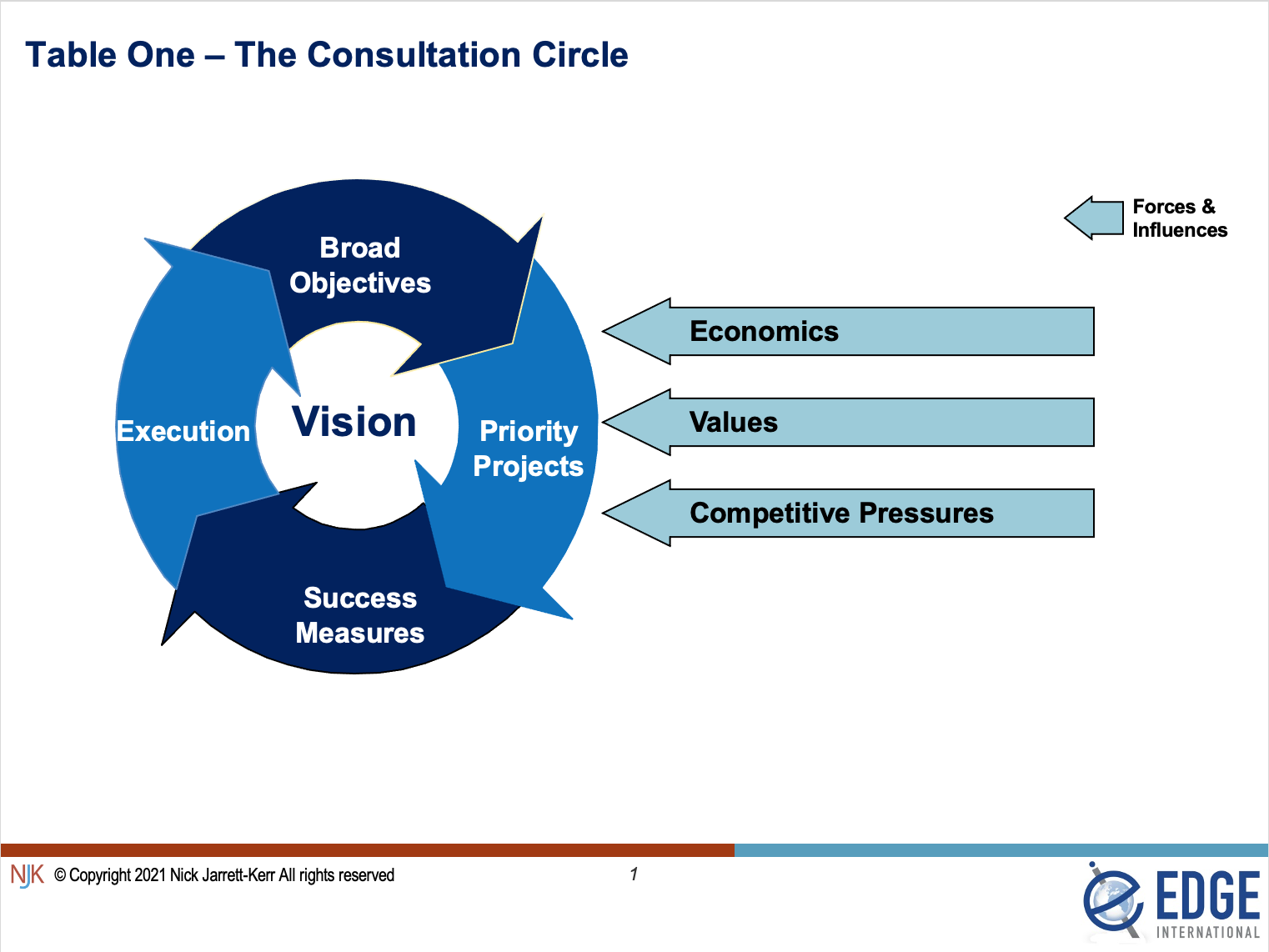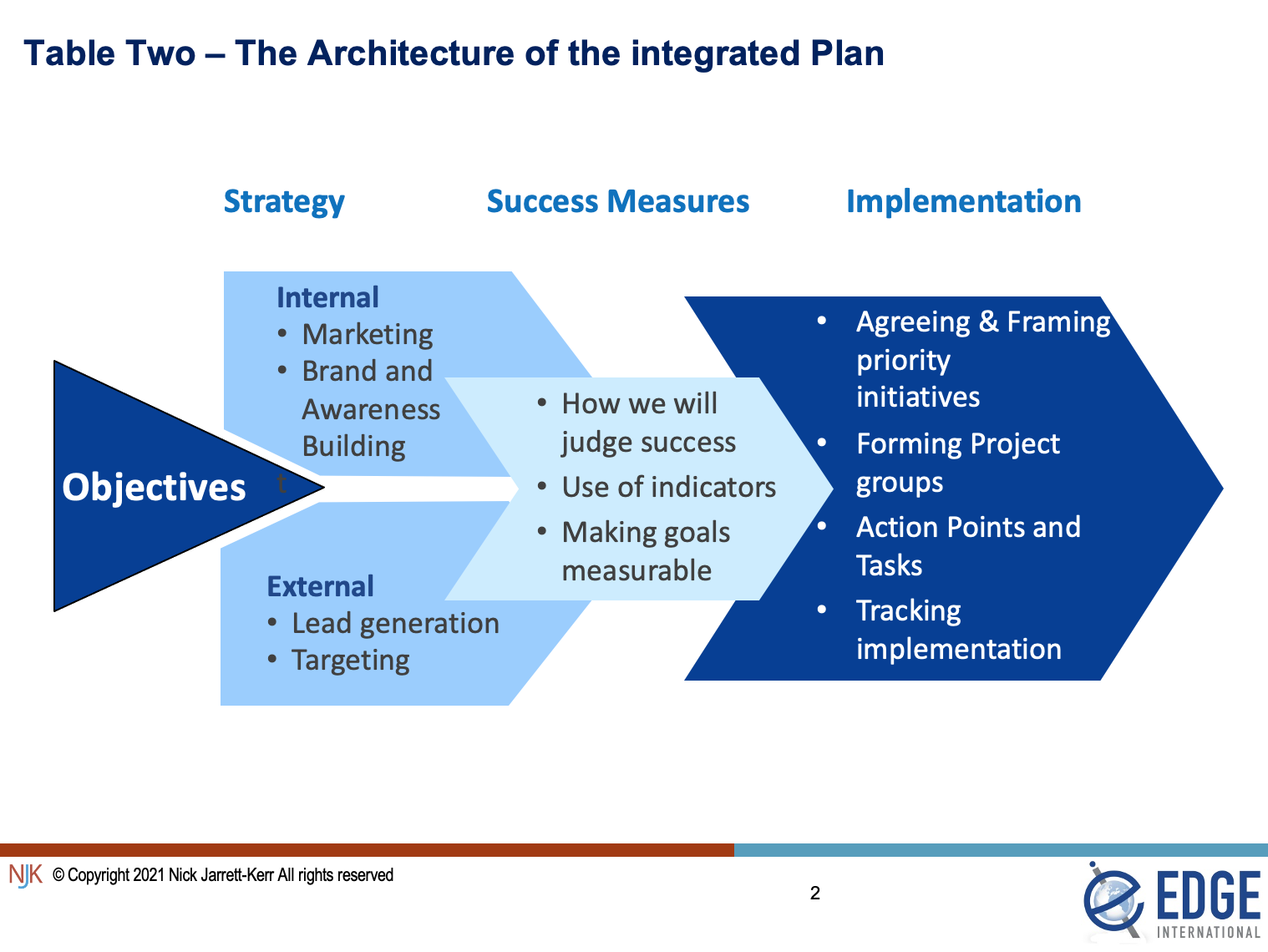Integrating Strategic Planning and Strategy Execution
Nick Jarrett-Kerr

Professional service firms are typically littered with uncompleted strategic projects, failed initiatives and strategic plans that have remained in a drawer (or a computer file) almost as soon as written. It has often been observed that professionals are better at ideas and planning than in putting those plans into reality by means of effective implementation. To state the rather obvious, any yawning gap between strategic planning and its implementation is a mistake. The job is not done when the firm has produced a finely honed strategic document, beautifully printed and glossily bound – however wide and comprehensive has been the consultation process. The danger comes from a mindset that assumes that the plan is a lofty leadership endeavour and that implementation is low-level operational stuff that can and should be delegated.
Strategic planning and strategy execution are best seen as an integrated and iterative process in which the broader and more visionary aspects are then cascaded down into action throughout the firm. In corporations, the leaders of the company for the most part craft the strategic choices involving larger long-term investments, and then tend to cascade the more concrete, day-to-day decisions down the hierarchical structure. Professional service firms (except the very large ones) tend to be smaller and less hierarchically layered than larger corporations but the same thinking applies to firms of all sizes; that the leaders should first agree and set out a broad path and vision which will hopefully stimulate the action that should follow lower down the organisation. The cascade imagery is helpful to a point but still has overtones of a hierarchical delegation. I prefer the imagery of a closed loop approach (such as illustrated in Table One) which stresses the collaborative aspects of strategic planning without which lawyers at the coal face will not take responsibility or ownership. It achieves this by facilitating an information consultation and feedback feature that enables plans to be checked and adjusted in the light of experience and outcomes. In this approach, rather like a ball being tossed and caught back and forth, or round and round, the purpose is to give all the participants in the process the opportunity, at each level, to help decide the implementation steps (and the accountability for these steps) to achieve each strategic priority project, and the accompanying success measures. This process of circling back is particularly important where there might be problems in capability or capacity (human or financial), and to establish what resources are be available and what commitments need to be made to address the execution of any plan that is agreed. All the time during this consultation phase, other forces and influences will arise to inform the discussions and processes – the firm’s financial health, the values the firm espouses and the competitive pressures that the firm faces being some of those.
After this process has been concluded, it is then possible (as illustrated in Table Two) to design and build a truly integrated plan that links all the essential moving parts and introduces lines of accountability and feedback. At this stage the broad path can be fleshed out with more detailed projects, timelines and actions. The magnitude of the current challenges to the professional service sector cannot be understated. If Table One is seen as a spinning wheel, then it needs to spin ever more speedily.
Partners: Escape Velocity Begins Now!
Mike WhiteWell thankfully, it’s a new year! As you do all that you can to reach “escape velocity” and set the table for great things in Q3 and Q4, I caution my clients to make a psychological commitment to put things in motion now to create a rich set of opportunities later in the year.
I spend time with many of my clients during this time of year to encourage them to initiate many “January-February meetings.” My recommendation takes two steps: i) between now and the end of January, send out emails to suspects, prospects, or target-rich existing clients inviting them to join with you on a 20-30 minute call; and, ii) between February 1 and February 28 have your “January-February meetings” with those who responded to your invitation.
What are “January-February meetings?” January-February is a time of year when your CSuite contacts are: i) no longer hassled by year-end 2020 issues; ii) thinking about 2021 priorities that they can point to with specificity and clarity; iii) not yet consumed by this day/this week 2021 urgencies; iv) most open to engaging in high value “thought partnering” discussions with smart people like you; and, v) most forthcoming in sharing with you all of their gaps/exposures, as well as their hopes and dreams for the coming year.
Executing on this strategy requires you to have a sense of urgency. Many of you are managing a number of well qualified, well developed discussions with mature prospects. In other words, between handling your existing client work and advancing your mature opportunities, you have plenty to say grace over. However, I encourage you to resist the urge to blow off current efforts to set up your “January-February meetings.” You have an unusual luxury now to put leverage to work for you that will soon evaporate.
Leverage? What leverage? The leverage you can and should make use of now is the single email template you can send out (with minor recipient-specific tweaking) to get many people to consider your request for a “January-February meeting.” A single email form sent out to many recipients- now that is leverage! In business-speak we call this “doing something at scale.”
So, what does this “email” look like? Subject to recipient-specific customization, your email could look like the below:
“_________,
This time of year, I try to schedule time in January and February with select companies to learn more about what the year ahead is going to look like. Given what we do, I’m always particularly interested in the ‘experiments’ companies are planning to run beyond ‘keep the trains running’ and normal course priorities. At this time, businesses are coming out of their planning cycle and isolating areas, gaps, and opportunities deserving of unusual attention. While these discussions on occasion reveal to us ‘engageable’ subject matter, more typically our listening tour helps us learn unconventional insights about company types/sectors on which we focus. In short, it helps us be smarter about you, and other companies like you.
Push me out as far as you need to but if you’d be game to get together this month or next, I’d welcome the opportunity to set up a call or schedule a virtual coffee . . .”
Get going- now is the time to strike!



